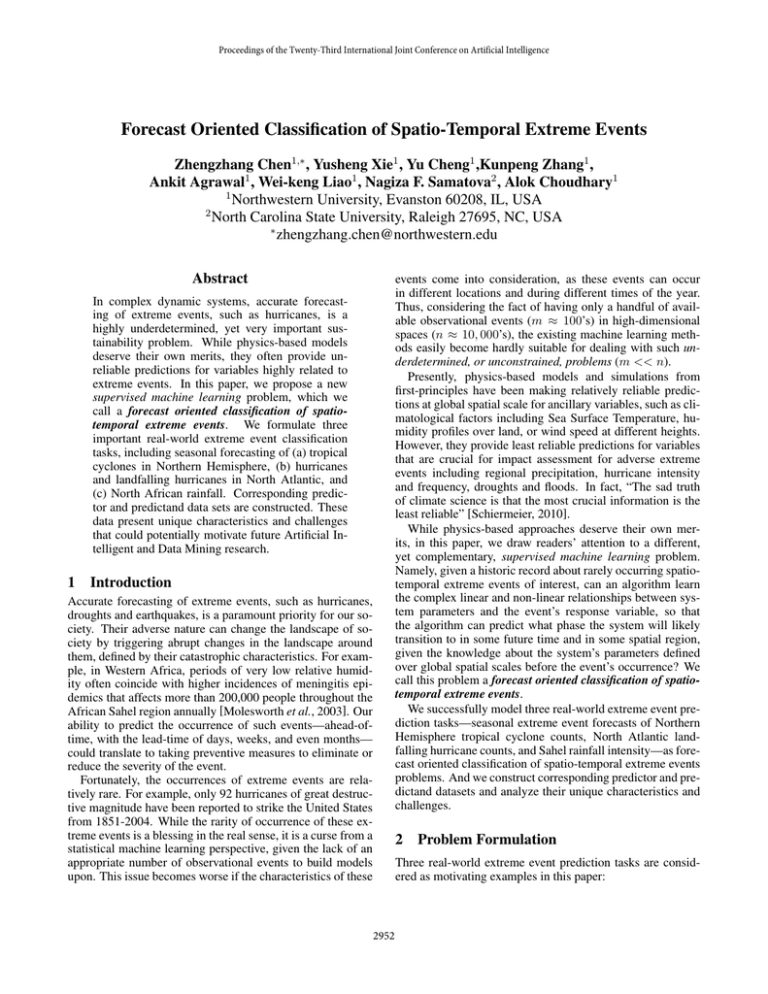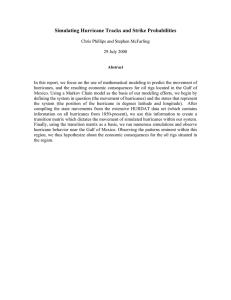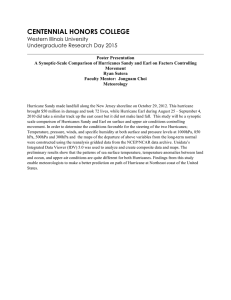Forecast Oriented Classification of Spatio-Temporal Extreme Events
advertisement

Proceedings of the Twenty-Third International Joint Conference on Artificial Intelligence
Forecast Oriented Classification of Spatio-Temporal Extreme Events
Zhengzhang Chen1,∗ , Yusheng Xie1 , Yu Cheng1 ,Kunpeng Zhang1 ,
Ankit Agrawal1 , Wei-keng Liao1 , Nagiza F. Samatova2 , Alok Choudhary1
1
Northwestern University, Evanston 60208, IL, USA
2
North Carolina State University, Raleigh 27695, NC, USA
∗
zhengzhang.chen@northwestern.edu
Abstract
events come into consideration, as these events can occur
in different locations and during different times of the year.
Thus, considering the fact of having only a handful of available observational events (m ≈ 100’s) in high-dimensional
spaces (n ≈ 10, 000’s), the existing machine learning methods easily become hardly suitable for dealing with such underdetermined, or unconstrained, problems (m << n).
Presently, physics-based models and simulations from
first-principles have been making relatively reliable predictions at global spatial scale for ancillary variables, such as climatological factors including Sea Surface Temperature, humidity profiles over land, or wind speed at different heights.
However, they provide least reliable predictions for variables
that are crucial for impact assessment for adverse extreme
events including regional precipitation, hurricane intensity
and frequency, droughts and floods. In fact, “The sad truth
of climate science is that the most crucial information is the
least reliable” [Schiermeier, 2010].
While physics-based approaches deserve their own merits, in this paper, we draw readers’ attention to a different,
yet complementary, supervised machine learning problem.
Namely, given a historic record about rarely occurring spatiotemporal extreme events of interest, can an algorithm learn
the complex linear and non-linear relationships between system parameters and the event’s response variable, so that
the algorithm can predict what phase the system will likely
transition to in some future time and in some spatial region,
given the knowledge about the system’s parameters defined
over global spatial scales before the event’s occurrence? We
call this problem a forecast oriented classification of spatiotemporal extreme events.
We successfully model three real-world extreme event prediction tasks—seasonal extreme event forecasts of Northern
Hemisphere tropical cyclone counts, North Atlantic landfalling hurricane counts, and Sahel rainfall intensity—as forecast oriented classification of spatio-temporal extreme events
problems. And we construct corresponding predictor and predictand datasets and analyze their unique characteristics and
challenges.
In complex dynamic systems, accurate forecasting of extreme events, such as hurricanes, is a
highly underdetermined, yet very important sustainability problem. While physics-based models
deserve their own merits, they often provide unreliable predictions for variables highly related to
extreme events. In this paper, we propose a new
supervised machine learning problem, which we
call a forecast oriented classification of spatiotemporal extreme events. We formulate three
important real-world extreme event classification
tasks, including seasonal forecasting of (a) tropical
cyclones in Northern Hemisphere, (b) hurricanes
and landfalling hurricanes in North Atlantic, and
(c) North African rainfall. Corresponding predictor and predictand data sets are constructed. These
data present unique characteristics and challenges
that could potentially motivate future Artificial Intelligent and Data Mining research.
1
Introduction
Accurate forecasting of extreme events, such as hurricanes,
droughts and earthquakes, is a paramount priority for our society. Their adverse nature can change the landscape of society by triggering abrupt changes in the landscape around
them, defined by their catastrophic characteristics. For example, in Western Africa, periods of very low relative humidity often coincide with higher incidences of meningitis epidemics that affects more than 200,000 people throughout the
African Sahel region annually [Molesworth et al., 2003]. Our
ability to predict the occurrence of such events—ahead-oftime, with the lead-time of days, weeks, and even months—
could translate to taking preventive measures to eliminate or
reduce the severity of the event.
Fortunately, the occurrences of extreme events are relatively rare. For example, only 92 hurricanes of great destructive magnitude have been reported to strike the United States
from 1851-2004. While the rarity of occurrence of these extreme events is a blessing in the real sense, it is a curse from a
statistical machine learning perspective, given the lack of an
appropriate number of observational events to build models
upon. This issue becomes worse if the characteristics of these
2
Problem Formulation
Three real-world extreme event prediction tasks are considered as motivating examples in this paper:
2952
Weather Bureau [Chu et al., 2007], and JTWC Northern Indian Ocean best track data. These datasets include hurricanes, tropical storms, typhoons, and cyclones that occurred
from July through November in the North Atlantic basin,
North Pacific basin, and Bengal and Arabian Sea basins. The
landfall hurricanes that strike land are distinguished by using the “Hit” feature of the HURDAT. Likewise, hurricanes
that made landfall in Mexico are also considered as landfall hurricanes in our analysis. Sahel rainfall indices from
1951–2004 are obtained by averaging seasonal (July through
September) mean Precipitation data over (10-20◦ N, 20W–
20◦ E). And monthly Precipitation data is obtained from the
Climate Research Unit at a 0.5◦ × 0.5◦ latitude and longitude
resolution for the 1951–2004 period.
The global monthly mean sea level pressure (SLP), precipitable water (PW), sea surface temperature (SST), tropospheric vertical wind shear (VWS), relative humidity
(RH) and wind speed (WSPD) data from preceding January
through June are used as predictors to forecast the North Atlantic, North Pacific, and Northern Indian TC and Sahel rainfall classes. SLP, PW, RH, and WSPD are NCEP/NCAR reanalysis datasets. They are available at a 2.5◦ × 2.5◦ latitude
and longitude resolution. SST is from the NOAA Climate
Diagnostic Center in Boulder, Colorado, at a resolution of
2◦ ×2◦ latitude and longitude. VWS is calculated by computing the square root of the sum of the square of the difference
in zonal wind component between 850 and 200 hPa levels
and the square of the difference in meridional wind component between 850 and 200 hPa levels from NCEP/NCAR reanalysis data. The six variables combined could contribute a
total of 411,480 features. All datasets are available at CUCIS
Center1 of Northwestern University.
1. Seasonal tropical cyclone prediction: The first task is
to forecast the seasonal tropical cyclone (TC) count in
some spatial regions including North Atlantic, North Pacific, and Northern Indian. TC includes hurricanes, tropical storms, typhoons, and cyclones.
2. Seasonal hurricane prediction: The second task is to
forecast the seasonal hurricane count, with emphasis on
landfall hurricanes. Hurricanes consists of the landfall
hurricanes and the offshore hurricanes. Hurricanes lead
to major natural disasters in the regions of landfall.
3. North Africa rainfall prediction: The third task is to
forecast the seasonal rainfall in North Africa, especially,
in the Sahel area, which is highly related to meningitis epidemics that affects more than 200,000 people
throughout the African Sahel region annually.
We model each of these extreme event forecasting tasks as
a forecast oriented, multi-class classification problem.
Formally, assume that the multi-phase system during the
extreme event e = (C, Tf , Le ) can be characterized by one
of its phases, C ∈ {C1 , C2 , . . . , Cs } at some future time
period Tf and in some event’s spatial location region Le .
Can the algorithm A predict C given the spatio-temporal
multivariate feature set F over space L ⊇ Le and time
T = (Tf − ΔT, Tf )? Note that the temporal resolution, ΔT ,
is domain-specific (e.g., 1–5 months for hurricanes). For the
sake of simplicity, we assume that the number s of distinct
system’s phases/states is finite. For example, the seasonal
hurricane activity can be broadly categorized as “above normal” (say, more than six hurricanes in a season), “normal,”
or “below normal” (say, less than four hurricanes in a season)
during hurricane season Tf = {July-November} in region
Le = {North America} [Chu et al., 2007]. We call this problem a forecast-oriented classification of spatio-temporal extreme events or F ORECAST for short.
The intent of our problem is not to predict an actual numerical magnitude of the response, instead to seek proper classification into unambiguous groupings that provide enough information to make proper decisions, as many regression models are ultimately being translated into such coarser scales
[Chu et al., 2007] for impact assessment. Thus, in this paper, all observed extreme event count series are classified into
three classes with a distribution of 40% as “normal” and 30%
each as “below normal” and “above normal.”
The F ORECAST problem is different from traditional classification machine learning problem, since F ORECAST aims
to forecast the future phase of the system given its characteristics prior to the time-frame of interest unlike existing classification problem that predicts what phase the system currently
belongs to, given its current characteristics.
3
3.1
3.2
Mathematical Abstraction
In traditional supervised classification, a model is learned
from a matrix representation of the original data with m rows
corresponding to a set E of observations, or events, and n
columns corresponding to a set F of features that characterize each event. In addition, a column vector associates each
event with its class from a finite set C of available classes.
Once learned, the model predicts what class the target event
defined over the same features F belongs to.
Both the forecasting nature of our problem and the multivariate spatio-temporal nature of the data necessitate a mathematical abstraction that could transform this data into a mathematical form suitable for a machine learning task, in general,
and forecast oriented classification, in particular.
Formally, let V be a set of variables (such as SST, SLP, and
VWS) that characterize the system over spatial locations L,
defined over spatial (latitude, longitude, altitude) grid points,
and over time period T (e.g., 1950-2011). And suppose that
each extreme event e can be classified based on some eventspecific classification taxonomy, C. In the context of the target extreme events, such
hurricanes
let us also
as or droughts,
assume that T = T1 T2 . . . Tm , where Ti Tj = ∅
and i = j, is divided into m coarse-grain time intervals (e.g.
m calendar years) during which an extreme event e can oc-
Data Construction and Challenges
Data
We construct seasonal tropical cyclone (TC) count series
from 1950 to 2011 of three main regions of Northern Hemisphere: North Atlantic, North Pacific, and Northern Indian.
These series are obtained from Atlantic hurricane database
(HURDAT) at the National Climatic Data Center, Central
1
2953
http://cucis.ece.northwestern.edu/projects/Expeditions/
cur over some spatial region Le ⊆ L with some probability. Let us further assume that each time interval Tj ∈ T
is partitioned into the fine- or coarse-grain observable Tj,o
time period and the coarse-grain forecastable Tj,f time period (Tj = Tj,o Tj,f and Tj,o = Ti,o , Tj,f = Ti,f , ∀i, j ∈
{1, 2, ..., m}).
Fig. 1 illustrates a mathematical abstraction using SST
and VWS as variables, or predictands, defined over T =
(1950 − 1952) during the months of T∗,o = {May, June}
over (latitude, longitude) spatial grid points for the sea-level
altitude. The class label is inferred based on the historical record of observed hurricanes in North America during
T∗,f = (July-November) hurricane season.
SST spatio-temporal data
^^dͺϬΣEͺ
ϬΣͺDĂLJ
^^dͺϬΣEͺ
ϬΣͺ:ƵŶĞ
^^dͺϮΣEͺ
ϬΣͺ:ƵŶĞ
ϭϵϱϬ
ϯ
ϰ
Ϯ
st^ͺϬΣEͺ
ϬΣͺDĂLJ
ϭϵϱϭ
ϯ
ϯ
ϰ
ϳ
ďŽǀĞ
ϭϵϱϮ
Ϯ
ϰ
ϱ
ϭϬ
EŽƌŵĂů
ϲ
4
Features, F: Variable_Latitude_Longitude_Time
Conclusion
In this paper, the spatio-temporal extreme event prediction
problem has been modeled as a new supervised machine
learning problem. We have constructed predictor and predictand data sets for three real-world extreme event prediction tasks including seasonal extreme event forecasts of
Northern Hemisphere tropical cyclone counts, North Atlantic
landfalling hurricane counts, and Sahel rainfall intensity.
Many interesting directions to explore the multivariate spatiotemporal extreme event data include designing new feature
selection technologies, building new ensemble of classifiers,
mining spatio-temporal relationships, etc.
ůĂƐƐ
Performance Evaluation Metrics
Several metrics can be used to evaluate F ORECAST’s performances: accuracy, Heidke Skill Score, Peirce Skill Score, and
Gerrity Skill Score [Jolliffe and Stephenson, 2003]. Accuracy
is defined as the ratio of the number of correctly classified
data points to the total number of data points in the test set.
Some preliminary results of the three real-world extreme
event prediction tasks can be found in our work [Chen et al.,
2011; 2012; 2013].
VWS spatio-temporal data
zĞĂƌ
Time T
3.4
ďŽǀĞ
Class C
Acknowledgments
Figure 1: A mathematical form for forecast oriented classification of hurricane events.
3.3
This work is supported in part by NSF awards CCF-0833131,
CNS-0830927, IIS-0905205, CCF-0938000, CCF-1029166,
and OCI-1144061; DOE awards DE-FG02-08ER25848,
DE-SC0001283, DE-SC0005309, DESC0005340, and
DESC0007456; AFOSR award FA9550-12-1-0458.
Challenges
Traditional machine learning methods would face a number
of technical challenges due to the characteristics of multivariate, spatio-temporal data, “the curse of dimensionality”, and
inter-correlated features.
• Multivariate, spatio-temporal nature: The data in real
world dynamic systems are often with multiple or even
tens of spatio-temporal variables (e.g., SST, SPL, VWS
etc.), which requires a methodology that could naturally support multi-variate spatio-temporal data, which,
to the best of our knowledge, no existing classification
methodologies are particularly designed for.
• The curse of dimensionality: Another difficulty is how
to deal with the enormous number of features that could
easily reach thousands or even hundreds of thousands.
Such enormous feature space could easily lead to the
problem, coined by Bellman as “the curse of dimensionality” [Bellman, 1961].
• Inter-correlated and non-linear relationships: It is often
the case that a coordinated, not independent, action of
several features determines what phase a given system is
in. Complex dynamic systems often operate in multiple
phases, described as having similar defining characteristics but whose feedbacks behave in nonlinear fashion.
Such non-linear cooperative or competing interactions
between the features often form hierarchical functional
modules (e.g., communities) that act not only on different spatial and temporal scales but also in response to
fluctuations induced by endogenous and exogenous factors.
References
[Bellman, 1961] R. E. Bellman. Adaptive control processes: a
guided tour. A Rand Corporation Research Study Series.
Princeton University Press, 1961.
[Chen et al., 2011] Z. Chen, T. Pansombut, and et al. Forecaster: Forecast oriented feature elimination-based classification of adverse spatio-temporal extremes. NCSU Technical
Report:1840.2/2408, 2011.
[Chen et al., 2012] Z. Chen, W. Hendrix, and et al. Discovery of
extreme events-related communities in contrasting groups of
physical system networks. Data Mining and Knowledge Discovery, 2012.
[Chen et al., 2013] Z. Chen, J. Jenkins, and et al. Automatic detection and correction of multi-class classification errors using
system whole-part relationships. SDM, 2013.
[Chu et al., 2007] P. S. Chu, X. Zhao, and et al. Climate prediction
of tropical cyclone activity in the vicinity of Taiwan using the
multivariate least absolute deviation regression method. Terr.
Atmos. Ocean. Sci., 18(4):805–825, October 2007.
[Jolliffe and Stephenson, 2003] I. T. Jolliffe and D. B. Stephenson.
Forecast Verification: A Practitioner’s Guide in Atmospheric
Science. Wiley and Sons, 2003.
[Molesworth et al., 2003] A. M. Molesworth, L. E. Cuevas, and et
al. Environmental risk and meningitis epidemics in Africa.
EID, 9(10):1287–1293, 2003.
[Schiermeier, 2010] Q. Schiermeier. The real holes in climate science. Nature, 463:284–287, 2010.
2954






